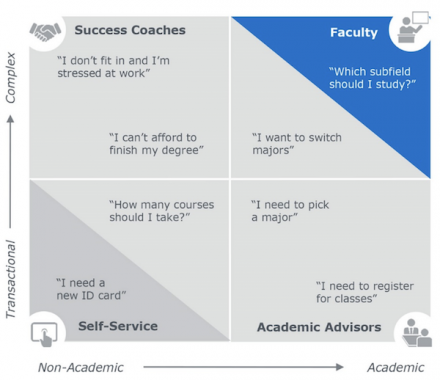La réduction de la distance transactionnelle est essentielle à la réussite des étudiants en ligne et se fait grâce aux efforts conjoints des administrateurs de l’établissement, du corps professoral et des concepteurs pédagogiques.
“…[L]’apprentissage en ligne peut augmenter la distance transactionnelle vécue, les étudiants se sentant dépassés pendant le processus initial de demande et d’inscription ; déconnectés du corps professoral, des pairs et des ressources ; et complètement éloignés de la culture universitaire. Tout au long de leur parcours académique, les apprenants en ligne sont confrontés à des défis qui n’ont jamais été vécus par les apprenants traditionnels sur les campus. Si les besoins d’interaction des apprenants ne sont pas pris en compte, ils se sentent isolés et déconnectés d’un environnement non réactif, ce qui peut les amener à se retirer d’un cours ou d’un programme en ligne.” (Major et Sumner, 2018, traduction libre)
Voici les facteurs les plus importants contribuant à la distance transactionnelle :
- Lack of contact or feedback about qualifications and missing application information
- Unresponsiveness from department (or program) of study about qualifications
- Unresponsiveness from coaches or advisors
- Lack of learner readiness
- Disconnection from academic and student support services Detachment from campus life
- Poor course design, particularly lack of class interactions
- Unresponsive instructors

Voici quelques éléments clés, pour réduire au minimum la distance transactionnelle :
- Working with prospective students through the application, admission, orientation and enrollment processes
- Cultivating a shared understanding of the “why”—the students’ motivations for pursuing an online degree
- Helping the students figure out how to be successful in their educational journey
- Providing connections to university resources, and being a liaison for the students between necessary points of contact
- Both developing routine meeting schedules as well as proactively outreaching to the students during deadlines or due dates
- Understanding what is currently happening for students at each point in their journeys
- Co-creating with the students clear success plans that account for the non-academic, life factors that may arise
- Co-creating with the students strategies to stay on track
- Motivating and advancing the students’ success plans at each meeting and interaction
- Working with the students to build their own accountability and self-efficacy
- Establishing and fostering connections with the university that are deemed critical for student success
Sources : Major, Amanda et Jennifer Sumner. Reducing Transactional Distance: Engaging Online Students in Higher Education. The EvoLLLution. Mars 2018.



